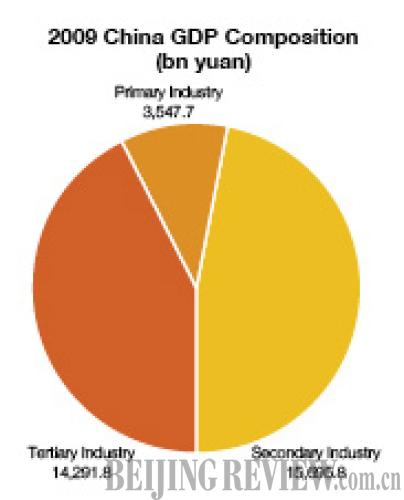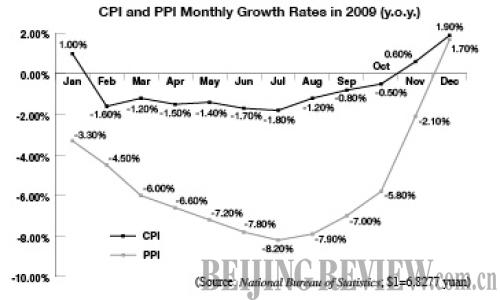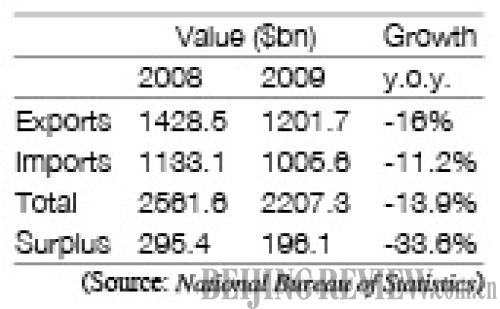| National Economy in 2009
Last year was one of the most difficult periods for China's economic development in the new century. Facing the global financial crisis, the government implemented a proactive fiscal policy and moderately loose monetary policy to fully implement and improve its stimulus packages. These efforts stopped the economy from sliding too far into negative territory and eventually allowed the national economy to recover quicker than anticipated.
According to preliminary estimates, the gross domestic product (GDP) for 2009 was 33.5 trillion yuan, up 8.7 percent. In terms of growth by quarters, it was up 6.2 percent for the first quarter and 7.9 percent, 9.1 percent and 10.7 percent for the second, third and fourth quarters, respectively.


Agriculture
Agricultural production continued to develop steadily, increasing for the sixth consecutive year. In 2009, the total output of grain reached 530.82 million tons, an increase of 0.4 percent over the previous year.
Industry
Industrial production picked up on a quarterly basis, as profits reversed their sharp declines. In 2009, the added value of industrial enterprises above the designated size (all state-owned enterprises and non-state enterprises with annual sales revenue exceeding 5 million yuan) was up 11 percent from 2008. In the first 11 months of 2009, the profits made by industrial enterprises above the designated size reached 2.6 trillion yuan, up 7.8 percent over the same period of last year.
Fixed-asset Investment
Investment continued to grow and investment in areas related to people's livelihoods increased noticeably. In 2009, total investment in fixed assets reached 22.48 trillion yuan, a year-on-year growth of 30.1 percent.
Retail Sales
Sales growth was steady and sales of selected products increased rapidly. In 2009, the total retail sales of consumer goods reached 12.5 trillion yuan, a growth of 15.5 percent.
CPI & PPI
The consumer price index (CPI) and producer price index (PPI) witnessed declines for the whole year. In 2009, the CPI was down 0.7 percent. The year-on-year change of producers' prices for manufactured goods was also down 5.4 percent.
Foreign Trade

The total value of imports and exports dropped in 2009, shifting between increases and decreases. The total value of exports was $1.2 trillion, down 16 percent; that of imports was $1 trillion, down by 11.2 percent. China had a trade surplus of $196.1 billion, or $99.4 billion less than 2008.
Resident Income
Urban and rural residents' incomes increased as the employment situation was better than expected. In 2009, the per-capita disposable income of urban residents was 17,175 yuan, up 8.8 percent. The per-capita net income of rural residents was 5,153 yuan, up 8.2 percent year on year.
Money Supply
The money supply grew rapidly—newly added credits increased by a large margin. At the end of December, broad money (M2) totaled 60.6 trillion yuan, up 27.7 percent compared with 2008; narrow money (M1) totaled 22.0 trillion yuan, up 32.4 percent; and cash in circulation (M0) was 3.82 trillion yuan, a rise of 11.8 percent.
(Source: National Bureau of Statistics; $1=6.8277 yuan) | 